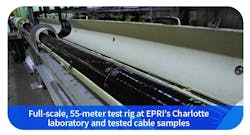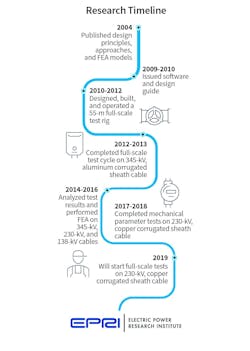Design Transmission Extruded-Dielectric Power Cable Systems Based on Cable’s Thermomechanical Behaviors
Industry Challenge
Underground transmission extruded-dielectric cables in North America are typically installed in duct-manhole systems where cable movement is restricted. The thermal expansion and contraction of an installed cable causes thermomechanical axial forces experienced along cable spans, joints, terminations, and their constraint systems. If not properly controlled, these compressive and tensile forces can lead to damage to cables and accessories and affect the reliability of the transmission cable system.
EPRI’s Response
For more than a decade, EPRI has performed fundamental research on methods to mitigate the impact of the thermomechanical forces through cable system designs. The results of these studies have been applied to installed cable restraint systems and included in industry guidance documents.
The EPRI studies include cable thermomechanical parameter testing and finite-element analysis (FEA) modeling of cables of various types. To verify and refine these FEA models, EPRI constructed a custom full-scale, 55-meter test rig in its Charlotte laboratory (see image). This test fixture allows researchers to control cable loading while measuring cable temperature at more than 150 points and cable movement along the cable length. These tests provide insights and verifications into how cables behave in duct-manhole systems. Using this information, researchers can develop design requirements and standardized measurement methods, and they can refine FEA parameters and models.
Progress, Results & Next Steps
Results of the EPRI studies have demonstrated that the thermomechanical forces of an extruded-dielectric transmission cable system can be considered in the engineering and design phases of a cable project. The approach includes methods to mitigate the effects of thermomechanical forces on a cable route. Mechanical testing of cable samples, especially during the early design and planning phases, can enhance the FEA models that are used in cable constraint and racking system design. By using these test results, utilities can improve duct-manhole restraint system designs, resulting in reduced system cost and improved grid reliability.
How to Use the Research
The EPRI research can be applied in many phases of a cable project, from engineering design to construction to installation and to operations and maintenance. The research results can improve engineering specifications to include thermomechanical aspects in the design, including cable route selection, cable clamping for supports of cable joints and terminations, and manhole sizing. The results can also be used for operations and maintenance of the cable lines, including rating considerations and inspection of cable movements and cable support systems within manholes. These results can have a significant impact on the cost and reliability of transmission power cable systems.
How to Get Involved
Utilities have the opportunity to work with EPRI to test additional cable types and sizes to increase the applicability of the results.
For additional information, please contact Dr. Tom Zhao, [email protected].
About the Author
Tom Zhao
Tom Zhao is the senior program manager responsible for EPRI’s underground transmission research.

